Advances in Engineering Software 69 (2014) 46–61
Contents lists available at ScienceDirect
Advances in Engineering Software
j o u r n a l h o m e p a g e : w w w . e l s e v i e r . c o m / l o c a t e / a d v e n g s o f t
Grey Wolf Optimizer
Seyedali Mirjalili a,⇑
, Seyed Mohammad Mirjalili b, Andrew Lewis a
a School of Information and Communication Technology, Griffith University, Nathan Campus, Brisbane QLD 4111, Australia
b Department of Electrical Engineering, Faculty of Electrical and Computer Engineering, Shahid Beheshti University, G.C. 1983963113, Tehran, Iran
a r t i c l e
i n f o
a b s t r a c t
Article history:
Received 27 June 2013
Received in revised form 18 October 2013
Accepted 11 December 2013
Available online 21 January 2014
Keywords:
Optimization
Optimization techniques
Heuristic algorithm
Metaheuristics
Constrained optimization
GWO
1. Introduction
This work proposes a new meta-heuristic called Grey Wolf Optimizer (GWO) inspired by grey wolves
(Canis lupus). The GWO algorithm mimics the leadership hierarchy and hunting mechanism of grey
wolves in nature. Four types of grey wolves such as alpha, beta, delta, and omega are employed for sim-
ulating the leadership hierarchy. In addition, the three main steps of hunting, searching for prey, encir-
cling prey, and attacking prey, are implemented. The algorithm is then benchmarked on 29 well-known
test functions, and the results are verified by a comparative study with Particle Swarm Optimization
(PSO), Gravitational Search Algorithm (GSA), Differential Evolution (DE), Evolutionary Programming
(EP), and Evolution Strategy (ES). The results show that the GWO algorithm is able to provide very com-
petitive results compared to these well-known meta-heuristics. The paper also considers solving three
classical engineering design problems (tension/compression spring, welded beam, and pressure vessel
designs) and presents a real application of the proposed method in the field of optical engineering. The
results of the classical engineering design problems and real application prove that the proposed algo-
rithm is applicable to challenging problems with unknown search spaces.
Ó 2013 Elsevier Ltd. All rights reserved.
Meta-heuristic optimization techniques have become very pop-
ular over the last two decades. Surprisingly, some of them such as
Genetic Algorithm (GA) [1], Ant Colony Optimization (ACO) [2],
and Particle Swarm Optimization (PSO) [3] are fairly well-known
among not only computer scientists but also scientists from differ-
ent fields. In addition to the huge number of theoretical works,
such optimization techniques have been applied in various fields
of study. There is a question here as to why meta-heuristics have
become remarkably common. The answer to this question can be
summarized into four main reasons: simplicity, flexibility, deriva-
tion-free mechanism, and local optima avoidance.
First, meta-heuristics are fairly simple. They have been mostly
inspired by very simple concepts. The inspirations are typically re-
lated to physical phenomena, animals’ behaviors, or evolutionary
concepts. The simplicity allows computer scientists to simulate dif-
ferent natural concepts, propose new meta-heuristics, hybridize
two or more meta-heuristics, or improve the current meta-heuris-
tics. Moreover, the simplicity assists other scientists to learn meta-
heuristics quickly and apply them to their problems.
Second, flexibility refers to the applicability of meta-heuristics
to different problems without any special changes in the structure
of the algorithm. Meta-heuristics are readily applicable to different
⇑ Corresponding author. Tel.: +61 434555738.
E-mail
addresses:
seyedali.mirjalili@griffithuni.edu.au
(S. Mirjalili),
mohammad.smm@gmail.com (S.M. Mirjalili), a.lewis@griffith.edu.au (A. Lewis).
0965-9978/$ - see front matter Ó 2013 Elsevier Ltd. All rights reserved.
http://dx.doi.org/10.1016/j.advengsoft.2013.12.007
problems since they mostly assume problems as black boxes. In
other words, only the input(s) and output(s) of a system are impor-
tant for a meta-heuristic. So, all a designer needs is to know how to
represent his/her problem for meta-heuristics.
In contrast
Third, the majority of meta-heuristics have derivation-free
mechanisms.
to gradient-based optimization ap-
proaches, meta-heuristics optimize problems stochastically. The
optimization process starts with random solution(s), and there is
no need to calculate the derivative of search spaces to find the opti-
mum. This makes meta-heuristics highly suitable for real problems
with expensive or unknown derivative information.
Finally, meta-heuristics have superior abilities to avoid local op-
tima compared to conventional optimization techniques. This is
due to the stochastic nature of meta-heuristics which allow them
to avoid stagnation in local solutions and search the entire search
space extensively. The search space of real problems is usually un-
known and very complex with a massive number of local optima,
so meta-heuristics are good options for optimizing these challeng-
ing real problems.
The No Free Lunch (NFL) theorem [4] is worth mentioning here.
This theorem has logically proved that there is no meta-heuristic
best suited for solving all optimization problems. In other words,
a particular meta-heuristic may show very promising results on a
set of problems, but the same algorithm may show poor perfor-
mance on a different set of problems. Obviously, NFL makes this
field of study highly active which results in enhancing current ap-
proaches and proposing new meta-heuristics every year. This also
�
S. Mirjalili et al. / Advances in Engineering Software 69 (2014) 46–61
47
motivates our attempts to develop a new meta-heuristic with
inspiration from grey wolves.
Generally speaking, meta-heuristics can be divided into two
main classes: single-solution-based and population-based. In the
former class (Simulated Annealing [5] for instance) the search pro-
cess starts with one candidate solution. This single candidate solu-
tion is then improved over the course of iterations. Population-
based meta-heuristics, however, perform the optimization using
a set of solutions (population). In this case the search process starts
with a random initial population (multiple solutions), and this
population is enhanced over the course of iterations. Population-
based meta-heuristics have some advantages compared to single
solution-based algorithms:
� Multiple candidate solutions share information about the
search space which results in sudden jumps toward the prom-
ising part of search space.
� Multiple candidate solutions assist each other to avoid locally
optimal solutions.
� Population-based meta-heuristics generally have greater explo-
ration compared to single solution-based algorithms.
One of the interesting branches of the population-based meta-
heuristics is Swarm Intelligence (SI). The concepts of SI was first
proposed in 1993 [6]. According to Bonabeau et al. [1], SI is ‘‘The
emergent collective intelligence of groups of simple agents’’. The inspi-
rations of SI techniques originate mostly from natural colonies,
flock, herds, and schools. Some of the most popular SI techniques
are ACO [2], PSO [3], and Artificial Bee Colony (ABC) [7]. A compre-
hensive literature review of the SI algorithms is provided in the
next section. Some of the advantages of SI algorithms are:
� SI algorithms preserve information about the search space over
the course of iteration, whereas Evolutionary Algorithms (EA)
discard the information of the previous generations.
� SI algorithms often utilize memory to save the best solution
obtained so far.
� SI algorithms usually have fewer parameters to adjust.
� SI algorithms have less operators compared to evolutionary
approaches (crossover, mutation, elitism, and so on).
� SI algorithms are easy to implement.
Regardless of the differences between the meta-heuristics, a
common feature is the division of the search process into two
phases: exploration and exploitation [8–12]. The exploration phase
refers to the process of investigating the promising area(s) of the
search space as broadly as possible. An algorithm needs to have sto-
chastic operators to randomly and globally search the search space
in order to support this phase. However, exploitation refers to the lo-
cal search capability around the promising regions obtained in the
exploration phase. Finding a proper balance between these two
phases is considered a challenging task due to the stochastic nature
of meta-heuristics. This work proposes a new SI technique with
inspiration from the social hierarchy and hunting behavior of grey
wolf packs. The rest of the paper is organized as follows:
Section 2 presents a literature review of SI techniques. Section 3
outlines the proposed GWO algorithm. The results and discussion
of benchmark functions, semi-real problems, and a real application
are presented in Sections 4-6, respectively. Finally, Section 7 con-
cludes the work and suggests some directions for future studies.
2. Literature review
Meta-heuristics may be classified into three main classes:
evolutionary, physics-based, and SI algorithms. EAs are usually
inspired by the concepts of evolution in nature. The most popular
algorithm in this branch is GA. This algorithm was proposed by
Holland in 1992 [13] and simulates Darwnian evolution concepts.
The engineering applications of GA were extensively investigated
by Goldberg [14]. Generally speaking, the optimization is done
by evolving an initial random solution in EAs. Each new population
is created by the combination and mutation of the individuals in
the previous generation. Since the best individuals have higher
probability of participating in generating the new population, the
new population is likely to be better than the previous genera-
tion(s). This can guarantee that the initial random population is
optimized over the course of generations. Some of the EAs are Dif-
ferential Evolution (DE) [15], Evolutionary Programing (EP) [16,17],
and Evolution Strategy (ES) [18,19], Genetic Programming (GP)
[20], and Biogeography-Based Optimizer (BBO) [21].
As an example, the BBO algorithm was first proposed by Simon
in 2008 [21]. The basic idea of this algorithm has been inspired by
biogeography which refers to the study of biological organisms in
terms of geographical distribution (over time and space). The case
studies might include different islands, lands, or even continents
over decades, centuries, or millennia. In this field of study different
ecosystems (habitats or territories) are investigated for finding the
relations between different species (habitants) in terms of immi-
gration, emigration, and mutation. The evolution of ecosystems
(considering different kinds of species such as predator and prey)
over migration and mutation to reach a stable situation was the
main inspiration of the BBO algorithm.
The second main branch of meta-heuristics is physics-based
techniques. Such optimization algorithms typically mimic physical
rules. Some of the most popular algorithms are Gravitational Local
Search (GLSA) [22], Big-Bang Big-Crunch (BBBC) [23], Gravitational
Search Algorithm (GSA) [24], Charged System Search (CSS) [25],
Central Force Optimization (CFO) [26], Artificial Chemical Reaction
Optimization Algorithm (ACROA) [27], Black Hole (BH) [28] algo-
rithm, Ray Optimization (RO) [29] algorithm, Small-World Optimi-
zation Algorithm (SWOA) [30], Galaxy-based Search Algorithm
(GbSA) [31], and Curved Space Optimization (CSO) [32]. The mech-
anism of these algorithms is different from EAs, in that a random
set of search agents communicate and move throughout search
space according to physical rules. This movement is implemented,
for example, using gravitational force, ray casting, electromagnetic
force, inertia force, weights, and so on.
For example, the BBBC algorithm was inspired by the big bang
and big crunch theories. The search agents of BBBC are scattered
from a point in random directions in a search space according to
the principles of the big bang theory. They search randomly and
then gather in a final point (the best point obtained so far) accord-
ing to the principles of the big crunch theory. GSA is another phys-
ics-based algorithm. The basic physical theory from which GSA is
inspired is Newton’s law of universal gravitation. The GSA algo-
rithm performs search by employing a collection of agents that
have masses proportional to the value of a fitness function. During
iteration, the masses are attracted to each other by the gravita-
tional forces between them. The heavier the mass, the bigger the
attractive force. Therefore, the heaviest mass, which is possibly
close to the global optimum, attracts the other masses in propor-
tion to their distances.
The third subclass of meta-heuristics is the SI methods. These
algorithms mostly mimic the social behavior of swarms, herds,
flocks, or schools of creatures in nature. The mechanism is almost
similar to physics-based algorithm, but the search agents navigate
using the simulated collective and social intelligence of creatures.
The most popular SI technique is PSO. The PSO algorithm was pro-
posed by Kennedy and Eberhart [3] and inspired from the social
behavior of birds flocking. The PSO algorithm employs multiple
particles that chase the position of the best particle and their
�
48
S. Mirjalili et al. / Advances in Engineering Software 69 (2014) 46–61
own best positions obtained so far. In other words, a particle is
moved considering its own best solution as well as the best solu-
tion the swarm has obtained.
Another popular SI algorithm is ACO, proposed by Dorigo et al.
in 2006 [2]. This algorithm was inspired by the social behavior of
ants in an ant colony. In fact, the social intelligence of ants in find-
ing the shortest path between the nest and a source of food is the
main inspiration of ACO. A pheromone matrix is evolved over the
course of iteration by the candidate solutions. The ABC is another
popular algorithm, mimicking the collective behavior of bees in
finding food sources. There are three types of bees in ABS: scout,
onlooker, and employed bees. The scout bees are responsible for
exploring the search space, whereas onlooker and employed bees
exploit the promising solutions found by scout bees. Finally, the
Bat-inspired Algorithm (BA), inspired by the echolocation behavior
of bats, has been proposed recently [33]. There are many types of
bats in the nature. They are different in terms of size and weight,
but they all have quite similar behaviors when navigating and
hunting. Bats utilize natural sonar in order to do this. The two main
characteristics of bats when finding prey have been adopted in
designing the BA algorithm. Bats tend to decrease the loudness
and increase the rate of emitted ultrasonic sound when they chase
prey. This behavior has been mathematically modeled for the BA
algorithm. The rest of the SI techniques proposed so far are as
follows:
� Marriage in Honey Bees Optimization Algorithm (MBO) in 2001
[34].
� Artificial Fish-Swarm Algorithm (AFSA) in 2003 [35].
� Termite Algorithm in 2005 [36].
� Wasp Swarm Algorithm in 2007 [37].
� Monkey Search in 2007 [38].
� Bee Collecting Pollen Algorithm (BCPA) in 2008 [39].
� Cuckoo Search (CS) in 2009 [40].
� Dolphin Partner Optimization (DPO) in 2009 [41].
� Firefly Algorithm (FA) in 2010 [42].
� Bird Mating Optimizer (BMO) in 2012 [43].
� Krill Herd (KH) in 2012 [44].
� Fruit fly Optimization Algorithm (FOA) in 2012 [45].
This list shows that there are many SI techniques proposed so
far, many of them inspired by hunting and search behaviors. To
the best of our knowledge, however, there is no SI technique in
the literature mimicking the leadership hierarchy of grey wolves,
well known for their pack hunting. This motivated our attempt
to mathematically model the social behavior of grey wolves, pro-
pose a new SI algorithm inspired by grey wolves, and investigate
its abilities in solving benchmark and real problems.
3. Grey Wolf Optimizer (GWO)
In this section the inspiration of the proposed method is first
discussed. Then, the mathematical model is provided.
3.1. Inspiration
Grey wolf (Canis lupus) belongs to Canidae family. Grey wolves
are considered as apex predators, meaning that they are at the top
of the food chain. Grey wolves mostly prefer to live in a pack. The
group size is 5–12 on average. Of particular interest is that they
have a very strict social dominant hierarchy as shown in Fig. 1.
The leaders are a male and a female, called alphas. The alpha is
mostly responsible for making decisions about hunting, sleeping
place, time to wake, and so on. The alpha’s decisions are dictated
to the pack. However, some kind of democratic behavior has also
been observed, in which an alpha follows the other wolves in the
pack. In gatherings, the entire pack acknowledges the alpha by
holding their tails down. The alpha wolf is also called the dominant
wolf since his/her orders should be followed by the pack [46]. The
alpha wolves are only allowed to mate in the pack. Interestingly,
the alpha is not necessarily the strongest member of the pack
but the best in terms of managing the pack. This shows that the
organization and discipline of a pack is much more important than
its strength.
The second level in the hierarchy of grey wolves is beta. The be-
tas are subordinate wolves that help the alpha in decision-making
or other pack activities. The beta wolf can be either male or female,
and he/she is probably the best candidate to be the alpha in case
one of the alpha wolves passes away or becomes very old. The beta
wolf should respect the alpha, but commands the other lower-level
wolves as well. It plays the role of an advisor to the alpha and dis-
cipliner for the pack. The beta reinforces the alpha’s commands
throughout the pack and gives feedback to the alpha.
The lowest ranking grey wolf is omega. The omega plays the
role of scapegoat. Omega wolves always have to submit to all the
other dominant wolves. They are the last wolves that are allowed
to eat. It may seem the omega is not an important individual in
the pack, but it has been observed that the whole pack face internal
fighting and problems in case of losing the omega. This is due to
the venting of violence and frustration of all wolves by the ome-
ga(s). This assists satisfying the entire pack and maintaining the
dominance structure. In some cases the omega is also the babysit-
ters in the pack.
If a wolf is not an alpha, beta, or omega, he/she is called subor-
dinate (or delta in some references). Delta wolves have to submit
to alphas and betas, but they dominate the omega. Scouts, senti-
nels, elders, hunters, and caretakers belong to this category. Scouts
are responsible for watching the boundaries of the territory and
warning the pack in case of any danger. Sentinels protect and guar-
antee the safety of the pack. Elders are the experienced wolves who
used to be alpha or beta. Hunters help the alphas and betas when
hunting prey and providing food for the pack. Finally, the caretak-
ers are responsible for caring for the weak, ill, and wounded wolves
in the pack.
In addition to the social hierarchy of wolves, group hunting is
another interesting social behavior of grey wolves. According to
Muro et al. [47] the main phases of grey wolf hunting are as
follows:
� Tracking, chasing, and approaching the prey.
� Pursuing, encircling, and harassing the prey until
it stops
moving.
� Attack towards the prey.
These steps are shown in Fig. 2.
In this work this hunting technique and the social hierarchy of
grey wolves are mathematically modeled in order to design GWO
and perform optimization.
Fig. 1. Hierarchy of grey wolf (dominance decreases from top down).
�
S. Mirjalili et al. / Advances in Engineering Software 69 (2014) 46–61
49
3.2. Mathematical model and algorithm
In this subsection the mathematical models of the social hierar-
chy, tracking, encircling, and attacking prey are provided. Then the
GWO algorithm is outlined.
3.2.1. Social hierarchy
In order to mathematically model the social hierarchy of wolves
when designing GWO, we consider the fittest solution as the alpha
(a). Consequently, the second and third best solutions are named
beta (b) and delta (d) respectively. The rest of the candidate solu-
tions are assumed to be omega (x). In the GWO algorithm the
hunting (optimization) is guided by a, b, and d. The x wolves fol-
low these three wolves.
3.2.2. Encircling prey
As mentioned above, grey wolves encircle prey during the hunt.
In order to mathematically model encircling behavior the follow-
ing equations are proposed:
~D ¼ j~C � ~XpðtÞ � ~XðtÞj
ð3:1Þ
~Xðt þ 1Þ ¼ ~XpðtÞ � ~A � ~D
ð3:2Þ
where t indicates the current iteration, ~A and ~C are coefficient vec-
tors, ~Xp is the position vector of the prey, and ~X indicates the posi-
tion vector of a grey wolf.
The vectors ~A and ~C are calculated as follows:
~A ¼ 2~a �~r1 � ~a
ð3:3Þ
ð3:4Þ
~C ¼ 2 �~r2
where components of ~a are linearly decreased from 2 to 0 over the
course of iterations and r1, r2 are random vectors in [0,1].
To see the effects of Eqs. (3.1) and (3.2), a two-dimensional po-
sition vector and some of the possible neighbors are illustrated in
Fig. 3(a). As can be seen in this figure, a grey wolf in the position of
(X, Y) can update its position according to the position of the prey
(X�, Y�). Different places around the best agent can be reached with
respect to the current position by adjusting the value of ~A and ~C
(X�–X, Y�) can be reached by setting
vectors. For instance,
~A ¼ ð1; 0Þ and ~C ¼ ð1; 1Þ. The possible updated positions of a grey
wolf in 3D space are depicted in Fig. 3(b). Note that the random
vectors r1 and r2 allow wolves to reach any position between the
points illustrated in Fig. 3. So a grey wolf can update its position in-
side the space around the prey in any random location by using
Eqs. (3.1) and (3.2).
The same concept can be extended to a search space with n
dimensions, and the grey wolves will move in hyper-cubes (or hy-
per-spheres) around the best solution obtained so far.
3.2.3. Hunting
Grey wolves have the ability to recognize the location of prey
and encircle them. The hunt is usually guided by the alpha. The
beta and delta might also participate in hunting occasionally. How-
ever, in an abstract search space we have no idea about the loca-
tion of the optimum (prey). In order to mathematically simulate
the hunting behavior of grey wolves, we suppose that the alpha
(best candidate solution) beta, and delta have better knowledge
about the potential location of prey. Therefore, we save the first
three best solutions obtained so far and oblige the other search
agents (including the omegas) to update their positions according
to the position of the best search agents. The following formulas
are proposed in this regard.
~Da ¼ j~C1 � ~Xa � ~Xj; ~Db ¼ j~C2 � ~Xb � ~Xj; ~Dd ¼ j~C3 � ~Xd � ~Xj
ð3:5Þ
~X1 ¼ ~Xa � ~A1 � ð~DaÞ; ~X2 ¼ ~Xb � ~A2 � ð~DbÞ; ~X3 ¼ ~Xd � ~A3 � ð~DdÞ
~Xðt þ 1Þ ¼ ~X1 þ ~X2 þ ~X3
3
ð3:6Þ
ð3:7Þ
Fig. 4 shows how a search agent updates its position according to
alpha, beta, and delta in a 2D search space. It can be observed that
the final position would be in a random place within a circle which
is defined by the positions of alpha, beta, and delta in the search
space. In other words alpha, beta, and delta estimate the position
of the prey, and other wolves updates their positions randomly
around the prey.
3.2.4. Attacking prey (exploitation)
As mentioned above the grey wolves finish the hunt by attack-
ing the prey when it stops moving. In order to mathematically
model approaching the prey we decrease the value of ~a. Note that
the fluctuation range of ~A is also decreased by ~a. In other words ~A is
a random value in the interval [�2a, 2a] where a is decreased from
2 to 0 over the course of iterations. When random values of ~A are in
[�1,1], the next position of a search agent can be in any position
Fig. 2. Hunting behavior of grey wolves: (A) chasing, approaching, and tracking prey (B–D) pursuiting, harassing, and encircling (E) stationary situation and attack [47].
�
50
S. Mirjalili et al. / Advances in Engineering Software 69 (2014) 46–61
X*-X
(X*-X,Y,Z)
(X*,Y,Z)
(X,Y,Z)
(X*-X,Y)
(X*,Y)
(X,Y)
(X*-X,Y,Z*)
(X*,Y,Z*)
(X,Y,Z*)
(X*-X,Y,Z*-Z)
(X*,Y,Z*-Z)
(X,Y,Z*-Z)
(X,Y*,Z)
(X*,Y*,Z*)
(X,Y*,Z*)
(X*-X,Y*,Z*-Z)
(X*,Y*,Z*-Z)
(X,Y*,Z*-Z)
(X,Y*-Y,Z)
Y
*
-
Y
(X,Y*)
(X,Y,Z*)
(X,Y*-Y)
(X*-X,Y*-Y,Z-Z*)
(X*,Y*-Y,Z*-Z)
(X,Y*-Y,Z*-Z)
(b)
Fig. 3. 2D and 3D position vectors and their possible next locations.
(X*,Y*)
(X*-X,Y*)
(X*-X,Y*-Y)
(X*,Y*-Y)
(a)
a1
C1
R
Dalpha
a2
C2
Dbeta
Move
Ddelta
a3
C3
Fig. 4. Position updading in GWO.
between its current position and the position of the prey. Fig. 5(a)
shows that |A| < 1 forces the wolves to attack towards the prey.
With the operators proposed so far, the GWO algorithm allows
its search agents to update their position based on the location of
the alpha, beta, and delta; and attack towards the prey. However,
the GWO algorithm is prone to stagnation in local solutions with
these operators. It is true that the encircling mechanism proposed
shows exploration to some extent, but GWO needs more operators
to emphasize exploration.
3.2.5. Search for prey (exploration)
Grey wolves mostly search according to the position of the al-
pha, beta, and delta. They diverge from each other to search for
prey and converge to attack prey. In order to mathematically mod-
el divergence, we utilize ~A with random values greater than 1 or
less than -1 to oblige the search agent to diverge from the prey.
This emphasizes exploration and allows the GWO algorithm to
search globally. Fig. 5(b) also shows that |A| > 1 forces the grey
wolves to diverge from the prey to hopefully find a fitter prey.
or any other hunters
Estimated position of the
prey
If |A|< 1
If |A|> 1
(a)
(b)
Fig. 5. Attacking prey versus searching for prey.
Another component of GWO that favors exploration is ~C. As may
be seen in Eq. (3.4), the ~C vector contains random values in [0,2].
This component provides random weights for prey in order to sto-
chastically emphasize (C > 1) or deemphasize (C < 1) the effect of
prey in defining the distance in Eq. (3.1). This assists GWO to show
�
S. Mirjalili et al. / Advances in Engineering Software 69 (2014) 46–61
51
a more random behavior throughout optimization, favoring explo-
ration and local optima avoidance. It is worth mentioning here that
C is not linearly decreased in contrast to A. We deliberately require
C to provide random values at all times in order to emphasize
exploration not only during initial iterations but also final itera-
tions. This component is very helpful in case of local optima stag-
nation, especially in the final iterations.
The C vector can be also considered as the effect of obstacles to
approaching prey in nature. Generally speaking, the obstacles in
nature appear in the hunting paths of wolves and in fact prevent
them from quickly and conveniently approaching prey. This is ex-
actly what the vector C does. Depending on the position of a wolf, it
can randomly give the prey a weight and make it harder and far-
ther to reach for wolves, or vice versa.
To sum up, the search process starts with creating a random
population of grey wolves (candidate solutions) in the GWO algo-
rithm. Over the course of iterations, alpha, beta, and delta wolves
estimate the probable position of the prey. Each candidate solution
updates its distance from the prey. The parameter a is decreased
from 2 to 0 in order to emphasize exploration and exploitation,
respectively. Candidate solutions tend to diverge from the prey
when j~Aj > 1 and converge towards the prey when j~Aj < 1. Finally,
the GWO algorithm is terminated by the satisfaction of an end
criterion.
The pseudo code of the GWO algorithm is presented in Fig. 6.
To see how GWO is theoretically able to solve optimization
problems, some points may be noted:
� The proposed social hierarchy assists GWO to save the best
solutions obtained so far over the course of iteration.
� The proposed encircling mechanism defines a circle-shaped
neighborhood around the solutions which can be extended to
higher dimensions as a hyper-sphere.
� The random parameters A and C assist candidate solutions to
have hyper-spheres with different random radii.
� The proposed hunting method allows candidate solutions to
locate the probable position of the prey.
� Exploration and exploitation are guaranteed by the adaptive
values of a and A.
� The adaptive values of parameters a and A allow GWO to
smoothly transition between exploration and exploitation.
� With decreasing A, half of the iterations are devoted to explora-
tion (|A| P 1) and the other half are dedicated to exploitation
(|A| < 1).
� The GWO has only two main parameters to be adjusted (a and
C).
There are possibilities to integrate mutation and other evolu-
tionary operators to mimic the whole life cycle of grey wolves.
Fig. 6. Pseudo code of the GWO algorithm.
However, we have kept the GWO algorithm as simple as possible
with the fewest operators to be adjusted. Such mechanisms are
recommended for future work. The source codes of this algorithm
can be found in http://www.alimirjalili.com/GWO.html and http://
www.mathworks.com.au/matlabcentral/fileexchange/44974.
4. Results and discussion
In this section the GWO algorithm is benchmarked on 29 bench-
mark functions. The first 23 benchmark functions are the classical
functions utilized by many researchers [16,48–51,82]. Despite the
simplicity, we have chosen these test functions to be able to compare
our results to those of the current meta-heuristics. These benchmark
functions are listed in Tables 1–3 where Dim indicates dimension of
the function, Range is the boundary of the function’s search space,
and fmin is the optimum. The other test beds that we have chosen
are six composite benchmark functions from a CEC 2005 special ses-
sion [52]. These benchmark functions are the shifted, rotated, ex-
panded, and combined variants of the classical functions which
offer the greatest complexity among the current benchmark func-
tions [53]. Tables 4 lists the CEC 2005 test functions, where Dim indi-
cates dimension of the function, Range is the boundary of the
function’s search space, and fmin is the optimum. Figs. 7–10 illustrate
the 2D versions of the benchmark functions used.
Generally speaking, the benchmark functions used are minimi-
zation functions and can be divided into four groups: unimodal,
multimodal, fixed-dimension multimodal, and composite func-
tions. Note that a detailed descriptions of the composite bench-
mark functions are available in the CEC 2005 technical report [52].
The GWO algorithm was run 30 times on each benchmark func-
tion. The statistical results (average and standard deviation) are re-
ported in Tables 5–8. For verifying the results, the GWO algorithm
is compared to PSO [3] as an SI-based technique and GSA [24] as a
physics-based algorithm. In addition, the GWO algorithm is com-
pared with three EAs: DE [15], Fast Evolutionary Programing
(FEP) [16], and Evolution Strategy with Covariance Matrix Adapta-
tion (CMA-ES) [18].
4.1. Exploitation analysis
According to the results of Table 5, GWO is able to provide very
competitive results. This algorithm outperforms all others in F1, F2,
and F7. It may be noted that the unimodal functions are suitable for
benchmarking exploitation. Therefore, these results show the
superior performance of GWO in terms of exploiting the optimum.
This is due to the proposed exploitation operators previously
discussed.
4.2. Exploration analysis
In contrast to the unimodal functions, multimodal functions
have many local optima with the number increasing exponentially
with dimension. This makes them suitable for benchmarking the
Table 1
Unimodal benchmark functions.
n
Q
i¼1jxij
P
Function
P
f1ðxÞ ¼
n
i¼1x2
i
P
P
i¼1jxij þ
f2ðxÞ ¼
n
i¼1ð
f3ðxÞ ¼
j�1xjÞ2
P
f4ðxÞ ¼ maxifjxij; 1 6 i 6 ng
P
n�1
f5ðxÞ ¼
i¼1 ½100ðxiþ1 � x2
P
f6ðxÞ ¼
i¼1ð½xi þ 0:5Þ2
n
f7ðxÞ ¼
i¼1ix4
n
n
i
i Þ2 þ ðxi � 1Þ2
i þ random½0; 1Þ
Dim
30
30
30
30
30
30
30
Range
[�100,100]
[�10,10]
[�100,100]
[�100,100]
[�30,30]
[�100,100]
[�1.28,1.28]
fmin
0
0
0
0
0
0
0
�
52
S. Mirjalili et al. / Advances in Engineering Software 69 (2014) 46–61
Table 2
Multimodal benchmark functions.
n
n
n
n
�
4000
�
n
i¼1x2
þ 20 þ e
n f10 sinðpy1Þ þ
�
� exp 1
þ 1
P
i¼1 cosð2pxiÞ
ffiffiffiffiffiffiffi
p
P
Function
P
Þ
jxij
i¼1 � xi sinð
F8ðxÞ ¼
q
ffiffiffiffiffiffiffiffiffiffiffiffiffiffiffiffiffiffiffi
�
P
i � 10 cosð2pxiÞ þ 10
i¼1½x2
F9ðxÞ ¼
� �
Q
P
F10ðxÞ ¼ �20 exp �0:2
n
1
i¼1x2
ffi
n
i
P
F11ðxÞ ¼ 1
i �
n
p
i¼1 cos xi
i
n�1
F12ðxÞ ¼ p
i¼1 ðyi � 1Þ2½1 þ 10 sin2ðpyiþ1Þ þ ðyn � 1Þ2g þ
yi ¼ 1 þ xiþ1
kðxi � aÞm
xi > a
uðxi; a; k; mÞ ¼
�a < xi < a
0
P
kð�xi � aÞm xi < �a
�
� �
�
P
i¼1ðxi � 1Þ2½1 þ sin2ð3pxi þ 1Þ þ ðxn � 1Þ2½1 þ sin2ð2pxnÞg þ
F13ðxÞ ¼ 0:1fsin2ð3px1Þ þ
P
P
i
h
i¼1 sinðxiÞ � sin i:x2
F14ðxÞ ¼ �
i
p
P
P
i¼1ðxi =bÞ2m � 2e�
F15ðxÞ ¼ e�
n
i¼1x2
i¼1 sin2ðxiÞ � expð�
F16ðxÞ ¼ f½
Q
; m ¼ 10
P
i¼1 cos2 xi; m ¼ 5
i Þg � exp½�
�
n
i¼1x2
ffiffiffiffiffiffiffi
jxij
i¼1 sin2
8<
:
p
2m
4
n
n
n
n
i
n
n
P
i¼1uðxi; 10; 100; 4Þ
n
P
i¼1uðxi; 5; 100; 4Þ
n
Dim
30
30
30
30
30
30
30
30
30
Range
[�500, 500]
[�5.12, 5.12]
[�32, 32]
[�600, 600]
[�50, 50]
fmin
�418.9829 � 5
0
0
0
0
[�50, 50]
[0,p]
[�20, 20]
[�10, 10]
0
�4.687
�1
�1
Table 3
Fixed-dimension multimodal benchmark functions.
2
2
11
25
j¼1
P
�
�1
P
1
i¼1ðxi�aijÞ6
�
Function
500 þ
F14ðxÞ ¼ 1
�
�
P
jþ
i þbix2Þ
i¼1 ai � x1ðb2
F15ðxÞ ¼
i þbix3þx4
b2
�
�
�
�
2 þ 4x4
1 þ x1x2 � 4x2
F16ðxÞ ¼ 4x2
1 þ 1
1 � 2:1x4
3 x6
2 þ 10 1 � 1
F17ðxÞ ¼ x2 � 5:1
1 þ 5
p x1 � 6
4p2 x2
8p
P
P
F18ðxÞ ¼ ½1 þ ðx1 þ x2 þ 1Þ2ð19 � 14x1 þ 3x2
P
P
F19ðxÞ ¼ �
i¼1ci expð�
j¼1aijðxj � pijÞ2Þ
P
i¼1ci expð�
F20ðxÞ ¼ �
j¼1aijðxj � pijÞ2Þ
P
i¼1½ðX � aiÞðX � aiÞT þ ci�1
F21ðxÞ ¼ �
P
i¼1½ðX � aiÞðX � aiÞT þ ci�1
F22ðxÞ ¼ �
i¼1½ðX � aiÞðX � aiÞT þ ci�1
F23ðxÞ ¼ �
10
2
4
3
4
6
5
7
cos x1 þ 10
1 � 14x2 þ 6x1x2 þ 3x2
2Þ � ½30 þ ð2x1 � 3x2Þ2 � ð18 � 32x1 þ 12x2
1 þ 48x2 � 36x1x2 þ 27x2
2Þ
Dim Range
2
4
2
2
2
3
6
4
4
4
[�65,65]
[�5,5]
[�5,5]
[�5,5]
[�2,2]
[1, 3]
[0, 1]
[0, 10]
[0, 10]
[0, 10]
fmin
1
0.00030
�1.0316
0.398
3
�3.86
�3.32
�10.1532
�10.4028
�10.5363
exploration ability of an algorithm. According to the results of
Tables 6 and 7, GWO is able to provide very competitive results
on the multimodal benchmark functions as well. This algorithm
outperforms PSO and GSA on the majority of the multimodal func-
tions. Moreover, GWO shows very competitive results compare to
DE and FEP; and outperforms them occasionally. These results
show that the GWO algorithm has merit in terms of exploration.
4.3. Local minima avoidance
The fourth class of benchmark functions employed includes
composite functions, generally very challenging test beds for
meta-heuristic algorithms. So, exploration and exploitation can
be simultaneously benchmarked by the composite functions.
Moreover, the local optima avoidance of an algorithm can be
examined due to the massive number of local optima in such test
functions. According to Table 8, GWO outperforms all others on
half of the composite benchmark functions. The GWO algorithm
also provides very competitive results on the remaining composite
benchmark functions. This demonstrates that GWO shows a good
balance between exploration and exploitation that results in high
local optima avoidance. This superior capability is due to the adap-
tive value of A. As mentioned above, half of the iterations are de-
voted to exploration (|A| P 1) and the rest
to exploitation
(|A| < 1). This mechanism assists GWO to provide very good explo-
ration, local minima avoidance, and exploitation simultaneously.
4.4. Convergence behavior analysis
In this subsection the convergence behavior of GWO is investi-
gated. According to Berg et al. [54], there should be abrupt changes
in the movement of search agents over the initial steps of optimi-
zation. This assists a meta-heuristic to explore the search space
extensively. Then, these changes should be reduced to emphasize
exploitation at the end of optimization. In order to observe the con-
vergence behavior of the GWO algorithm, the search history and
trajectory of the first search agent in its first dimension are illus-
trated in Fig. 11. The animated versions of this figure can be found
in Supplementary Materials. Note that the benchmark functions
are shifted in this section, and we used six search agents to find
the optima.
The second column of Fig. 11 depicts the search history of the
search agents. It may be observed that the search agents of GWO
tend to extensively search promising regions of the search spaces
and exploit the best one. In addition, the fourth column of Fig. 11
shows the trajectory of the first particle, in which changes of the
first search agent in its first dimension can be observed. It can be
seen that there are abrupt changes in the initial steps of iterations
which are decreased gradually over the course of
iterations.
According to Berg et al. [54], this behavior can guarantee that a
SI algorithm eventually convergences to a point in search space.
To sum up, the results verify the performance of the GWO algo-
rithm in solving various benchmark functions compared to well-
known meta-heuristics. To further investigate the performance of
�
S. Mirjalili et al. / Advances in Engineering Software 69 (2014) 46–61
53
Table 4
Composite benchmark functions.
Function
F24(CF1):
f1, f2, f3, . . ., f10 = Sphere Function
½,1; ,2; ,3; . . . ; ,10 ¼ ½1; 1; 1; . . . ; 1
[k1, k2, k3 . . ., k10] = [5/100, 5/100, 5/100, . . ., 5/100]
F25(CF2):
f1, f2, f3, . . ., f10 = Griewank’s Function
½,1; ,2; ,3; . . . ; ,10 ¼ ½1; 1; 1; . . . ; 1
[k1, k2, k3, . . ., k10] = [5/100, 5/100, 5/100, . . ., 5/100]
F26(CF3):
f1, f2, f3, . . ., f10 = Griewank’s Function
½,1; ,2; ,3; . . . ; ,10 ¼ ½1; 1; 1; . . . ; 1
[k1, k2, k3, . . ., k10] = [1, 1, 1, . . ., 1]
F27(CF4):
f1, f2 = Ackley’s Function
f3, f4 = Rastrigin’s Function
f5, f6 = Weierstras’s Function
f7, f8 = Griewank’s Function
f9, f10 = Sphere Function
½,1; ,2; ,3; . . . ; ,10 ¼ ½1; 1; 1; . . . ; 1
[k1, k2, k3, . . ., k10] = [5/32, 5/32, 1, 1, 5/0.5, 5/0.5, 5/100, 5/100, 5/100, 5/100]
F28(CF5):
f1, f2 = Rastrigin’s Function
f3, f4 = Weierstras’s Function
f5, f6 = Griewank’s Function
f7, f8 = Ackley’s Function
f9, f10 = Sphere Function
½,1; ,2; ,3; . . . ; ,10 ¼ ½1; 1; 1; . . . ; 1
[k1, k2, k3, . . ., k10] = [1/5, 1/5, 5/0.5, 5/0.5, 5/100, 5/100, 5/32, 5/32, 5/100, 5/100]
f29(CF6):
f1, f2 = Rastrigin’s Function
f3, f4 = Weierstras’s Function
f5, f6 = Griewank’s Function
f7, f8 = Ackley’s Function
f9, f10 = Sphere Function
½,1; ,2; ,3; . . . ; ,10 ¼ ½0:1; 0:2; 0:3; 0:4; 0:5; 0:6; 0:7; 0:8; 0:9; 1
[k1, k2, k3, . . ., k10] = [0.1 � 1/5, 0.2 � 1/5, 0.3 � 5/0.5, 0.4 � 5/0.5, 0.5 � 5/100, 0.6 � 5/100, 0.7 � 5/32, 0.8 � 5/32, 0.9 � 5/100, 1 � 5/100]
Dim
Range
fmin
10
10
10
10
[�5, 5]
[�5, 5]
[�5, 5]
[�5, 5]
10
[�5, 5]
10
[�5, 5]
0
0
0
0
0
0
(F1)
(F2)
(F3)
(F4)
(F5)
(F6)
(F7)
Fig. 7. 2-D versions of unimodal benchmark functions.
the proposed algorithm, three classical engineering design prob-
lems and a real problem in optical engineering are employed in
the following sections. The GWO algorithm is also compared with
well-known techniques to confirm its results.
5. GWO for classical engineering problems
In this section three constrained engineering design problems:
tension/compression spring, welded beam, and pressure vessel
designs, are employed. These problems have several equality and
inequality constraints, so the GWO should be equipped with a con-
straint handling method to be able to optimize constrained prob-
lems as well. Generally speaking, constraint handling becomes
very challenging when the fitness function directly affects the posi-
tion updating of the search agents (GSA for instance). For the fitness
independent algorithms, however, any kind of constraint handling
can be employed without the need to modify the mechanism of
the algorithm (GA and PSO for instance). Since the search agents of
the proposed GWO algorithm update their positions with respect
�
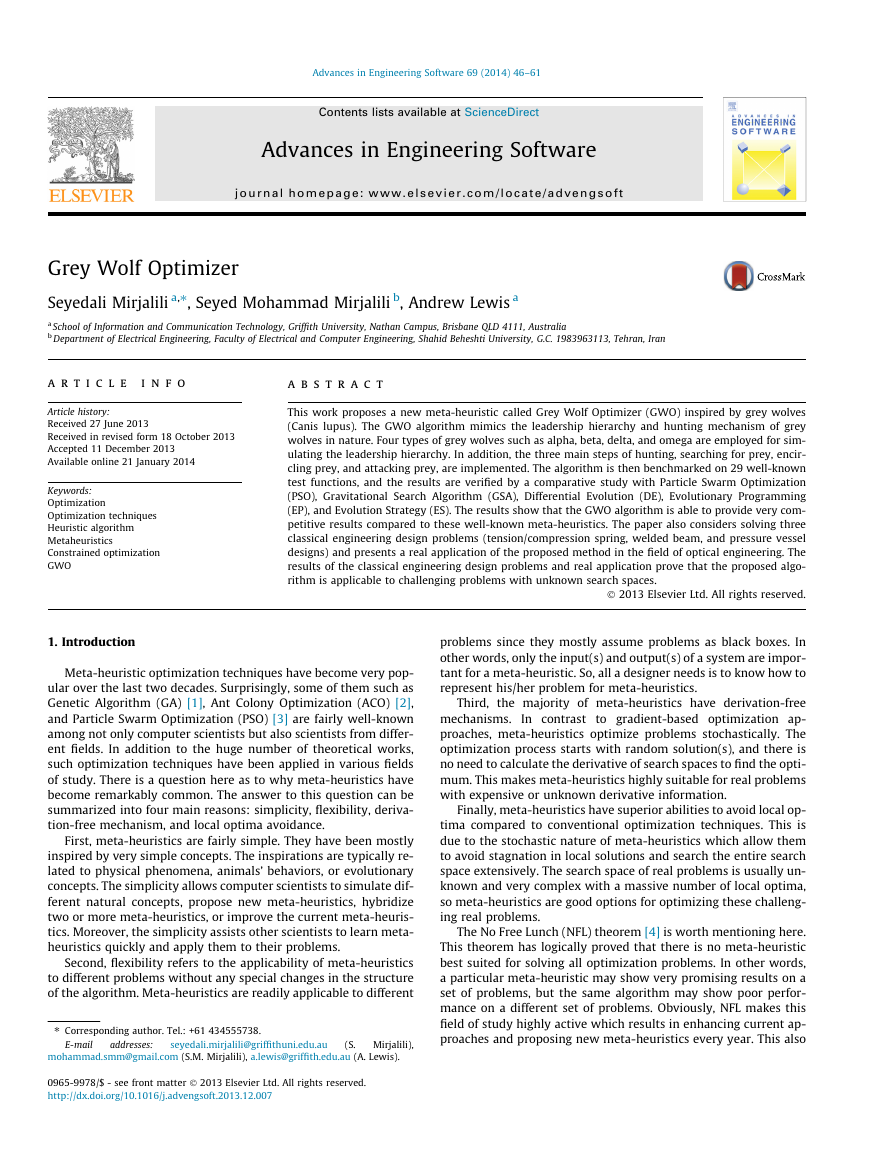
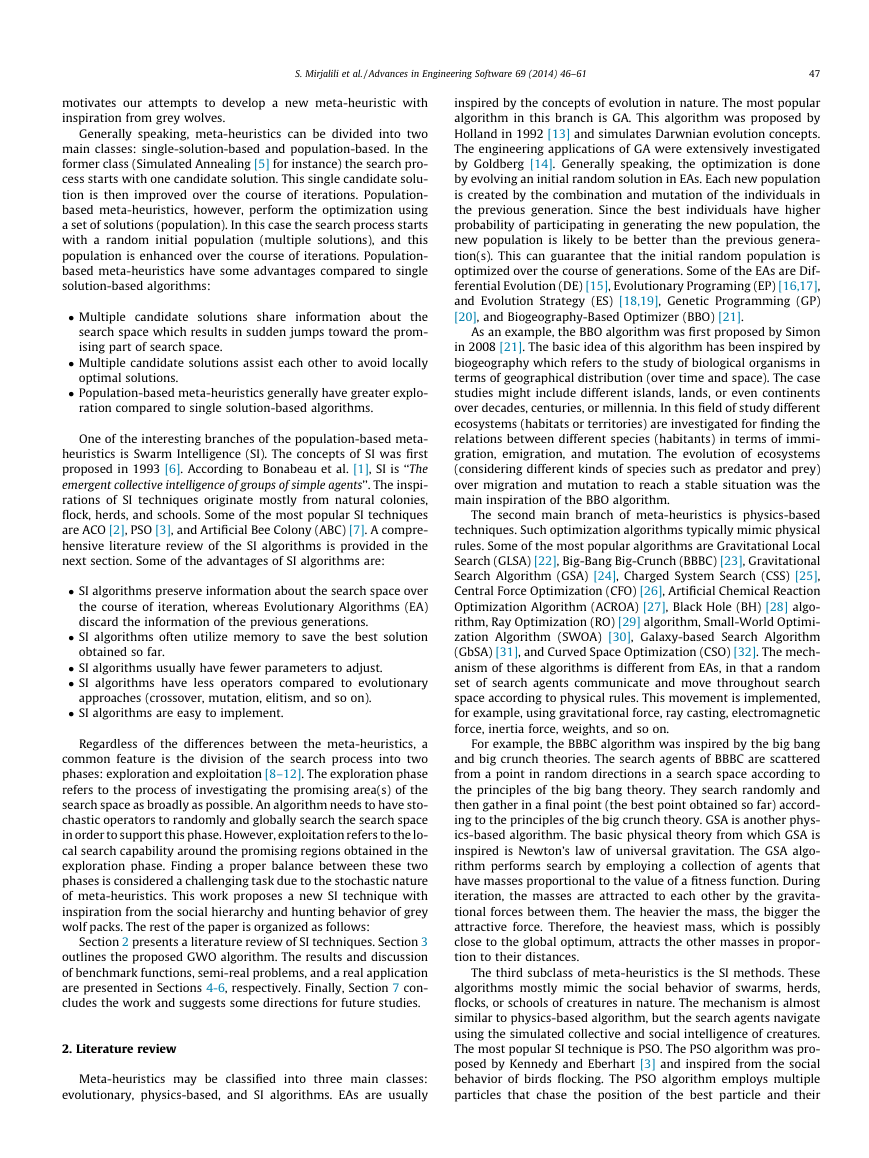
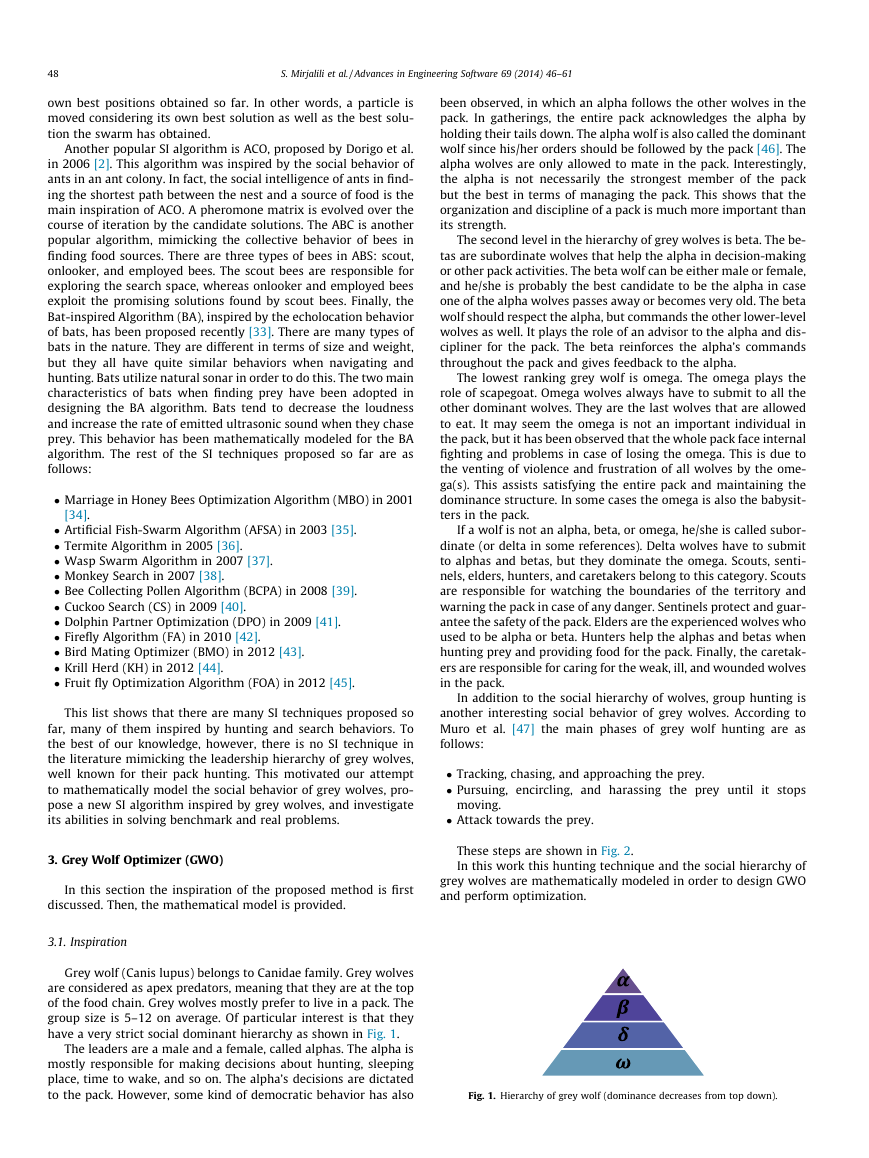
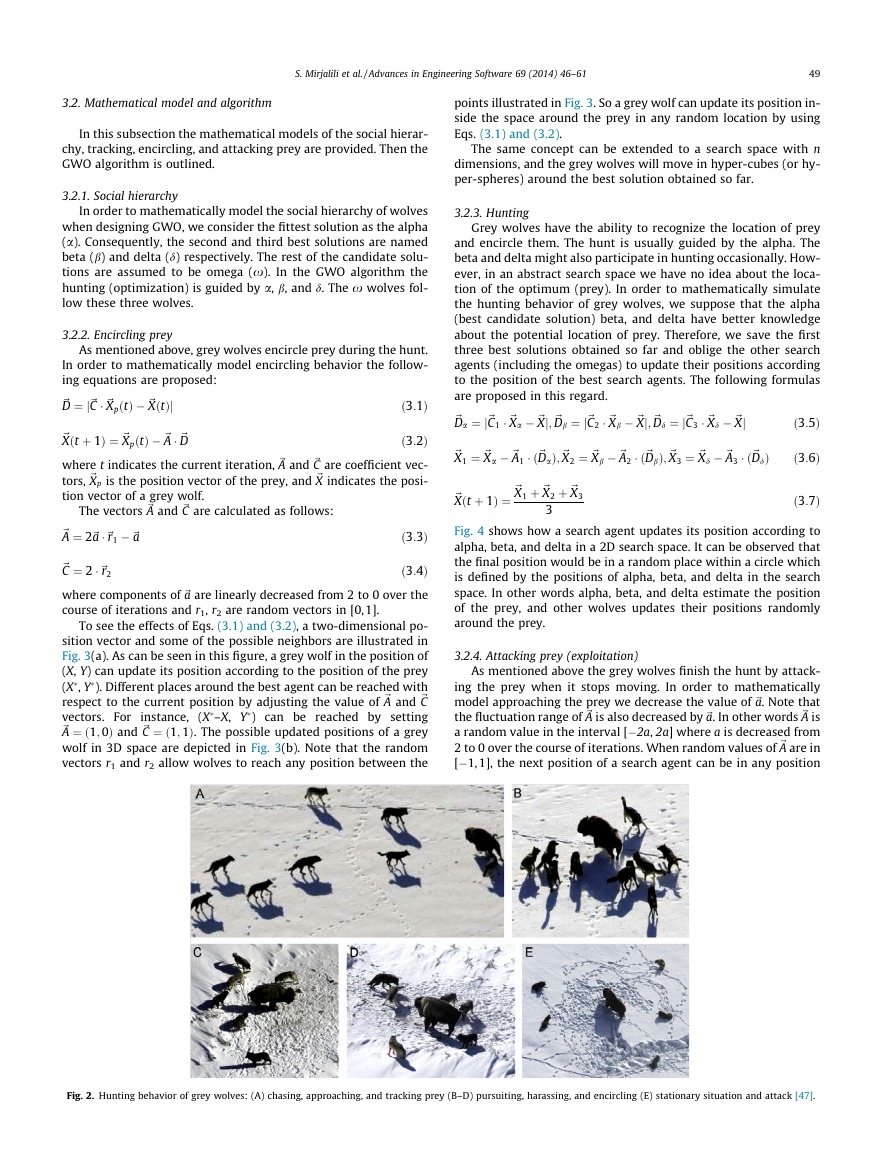
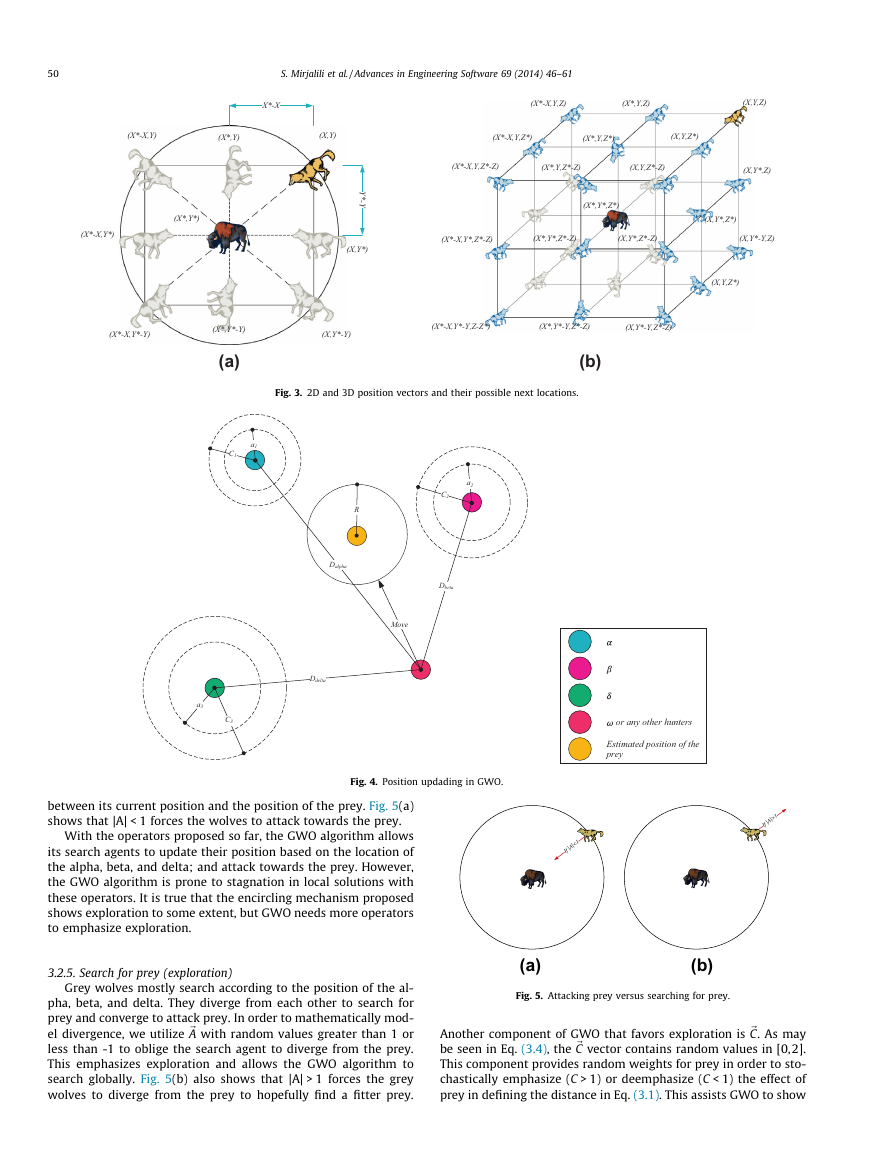
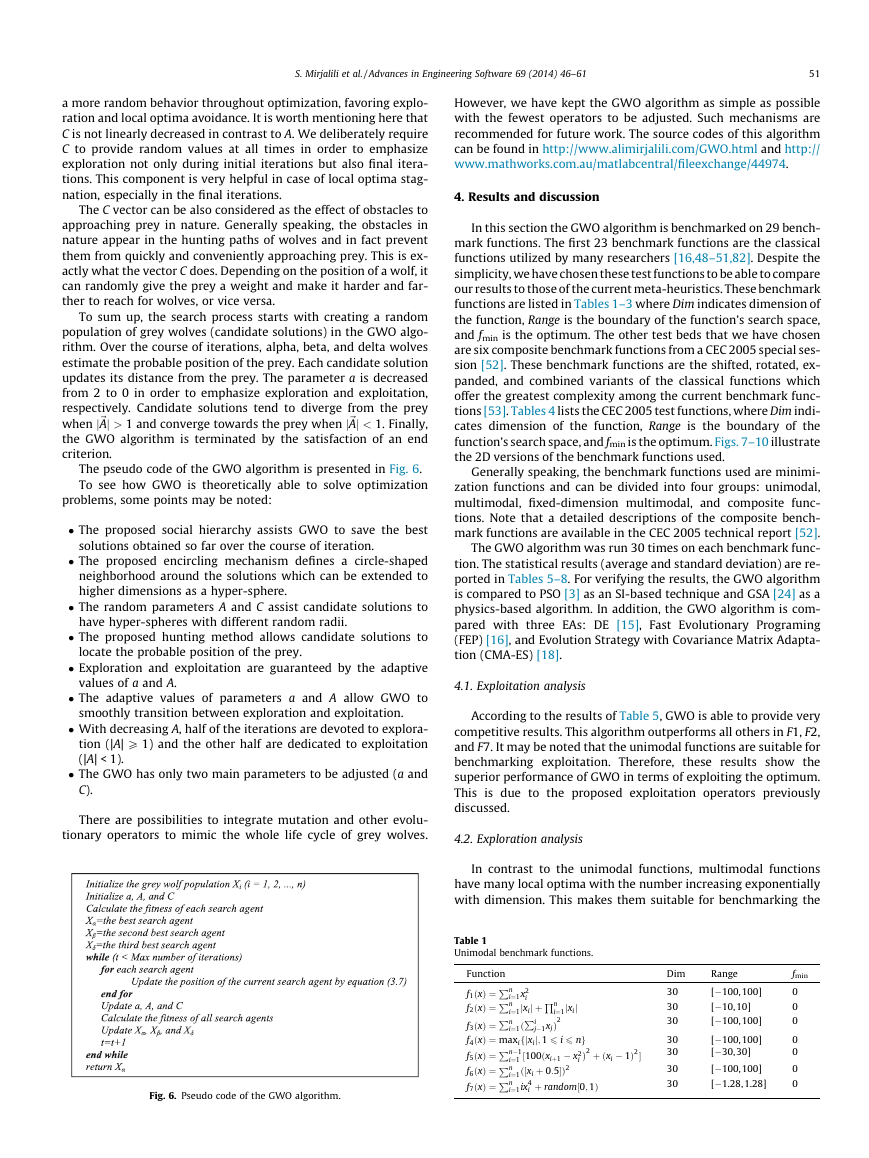

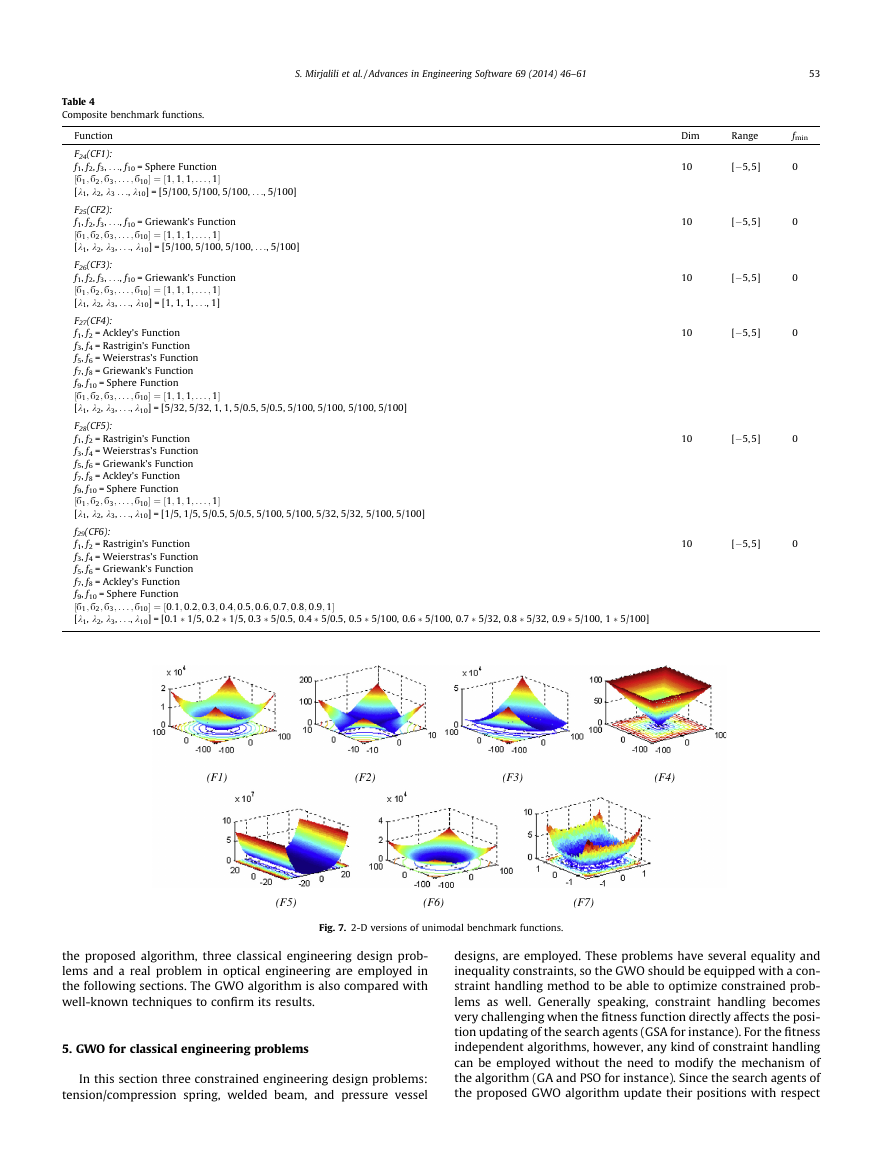








 2023年江西萍乡中考道德与法治真题及答案.doc
2023年江西萍乡中考道德与法治真题及答案.doc 2012年重庆南川中考生物真题及答案.doc
2012年重庆南川中考生物真题及答案.doc 2013年江西师范大学地理学综合及文艺理论基础考研真题.doc
2013年江西师范大学地理学综合及文艺理论基础考研真题.doc 2020年四川甘孜小升初语文真题及答案I卷.doc
2020年四川甘孜小升初语文真题及答案I卷.doc 2020年注册岩土工程师专业基础考试真题及答案.doc
2020年注册岩土工程师专业基础考试真题及答案.doc 2023-2024学年福建省厦门市九年级上学期数学月考试题及答案.doc
2023-2024学年福建省厦门市九年级上学期数学月考试题及答案.doc 2021-2022学年辽宁省沈阳市大东区九年级上学期语文期末试题及答案.doc
2021-2022学年辽宁省沈阳市大东区九年级上学期语文期末试题及答案.doc 2022-2023学年北京东城区初三第一学期物理期末试卷及答案.doc
2022-2023学年北京东城区初三第一学期物理期末试卷及答案.doc 2018上半年江西教师资格初中地理学科知识与教学能力真题及答案.doc
2018上半年江西教师资格初中地理学科知识与教学能力真题及答案.doc 2012年河北国家公务员申论考试真题及答案-省级.doc
2012年河北国家公务员申论考试真题及答案-省级.doc 2020-2021学年江苏省扬州市江都区邵樊片九年级上学期数学第一次质量检测试题及答案.doc
2020-2021学年江苏省扬州市江都区邵樊片九年级上学期数学第一次质量检测试题及答案.doc 2022下半年黑龙江教师资格证中学综合素质真题及答案.doc
2022下半年黑龙江教师资格证中学综合素质真题及答案.doc